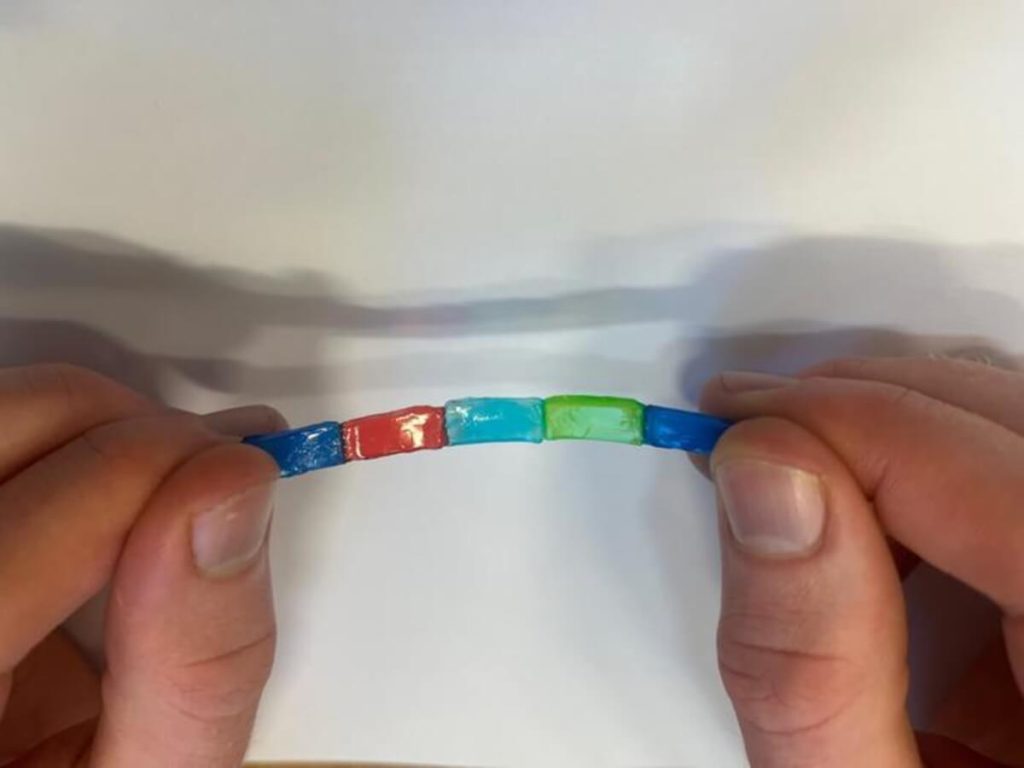

Researchers have developed soft, stretchable ‘jelly batteries’ that could be used for wearable devices or soft robotics, or even implanted in the brain to deliver drugs or treat conditions such as epilepsy. (Credit: University of Cambridge)
In a nutshell
- Cambridge scientists have created stretchy, self-healing “jelly batteries” that can extend to 15 times their length while maintaining electrical conductivity – a combination never achieved before in a single material
- The materials repair themselves within hours of damage and could revolutionize medical implants, as they match human tissue properties and are less likely to be rejected by the body
- Inspired by electric eels, these hydrogels can generate power like a battery (about 1/10th of a AA battery’s voltage) and maintain stable performance even when stretched 50% – five times better than previous versions
CAMBRIDGE, England — The next generation of medical devices won’t just interact with the human body, they’ll move and flex with it. University of Cambridge researchers have created remarkable “jelly batteries” that stretch, conduct electricity, and even heal themselves, potentially revolutionizing everything from brain implants to wearable health monitors.
Unlike traditional electronics, which rely on rigid metal components and wires, these new materials are primarily water-based and can stretch to more than 15 times their original length without losing their ability to conduct electricity. The breakthrough, published in Science Advances, overcomes a fundamental challenge in materials science.
“It’s difficult to design a material that is both highly stretchable and highly conductive since those two properties are normally at odds with one another,” explains lead author Stephen O’Neill from Cambridge’s Yusuf Hamied Department of Chemistry, in a statement. “Typically, conductivity decreases when a material is stretched.”
A research team from the University of Cambridge solved this challenge by creating special hydrogels, which are materials composed of 3D networks of polymers containing over 60% water. These hydrogels use the same principle as our own bodies to conduct electricity, carrying charges through ions rather than electrons like traditional electronics.


University of Cambridge)
“Normally, hydrogels are made of polymers that have a neutral charge, but if we charge them, they can become conductive,” says co-author Dr. Jade McCune. “And by changing the salt component of each gel, we can make them sticky and squish them together in multiple layers, so we can build up a larger energy potential.”
The secret to these materials’ remarkable properties lies in their molecular structure. The researchers developed a system using special barrel-shaped molecules called cucurbiturils, which act like molecular handcuffs to bind different layers of the material together. These bonds can repeatedly break and reform, allowing the material to stretch, compress, and even heal itself when damaged.
This self-healing capability is particularly impressive. When the material is cut, it can repair itself within minutes. Tests showed that after just two hours of healing time, the material recovers 90% of its original stretchability. The team demonstrated this by cutting samples in half and watching them fuse back together, tracking the healing process using fluorescent dyes under a microscope.
Taking inspiration from electric eels, which stun their prey using special cells called electrocytes, the researchers created a working prototype of a soft, stretchable power source. By stacking different types of their conductive gels together in layers, they built a device that generates electricity through ion concentration gradients, similar to how electric eels produce their shock.
The device produces about 115-125 millivolts (roughly a tenth of an AA battery’s voltage), and by connecting two cells in series, they could double this to around 248 millivolts. Most importantly, it maintains stable performance even when stretched up to 50%, which is about the same amount human skin can stretch. Previous attempts at similar devices would fail at just a 10% stretch.


“We can customize the mechanical properties of the hydrogels so they match human tissue,” explains Professor Scherman. “Since they contain no rigid components such as metal, a hydrogel implant would be much less likely to be rejected by the body or cause the build-up of scar tissue.”
Beyond medical applications, these materials could revolutionize soft robotics, machines designed to interact safely with humans or handle delicate objects. The combination of flexibility, conductivity, and durability could enable robots that move more naturally and adapt better to their environment.
The materials are remarkably resilient in other ways, too. They can be compressed by more than 90% without permanently losing their shape, and they bounce back within 30 seconds, though some variations show minor delays in full recovery. This level of durability, combined with their self-healing properties, suggests they could last longer than traditional electronic components in many applications.
This invention is a significant step forward in creating electronics that adapt to humans rather than forcing humans to adapt to electronics. As testing continues, they could fundamentally change our approach to everything from medical implants to wearable devices.
Paper Summary
Methodology
The researchers created these hydrogels by combining water-based polymers with specially designed molecular structures that can form reversible bonds. The key innovation was using barrel-shaped molecules called cucurbiturils as tiny molecular containers that can hold and release other molecules, creating dynamic links between polymer chains. They tested several types of charged molecules to create different versions of the hydrogel, each with unique properties. The team used multiple testing methods including mechanical stretching tests, electrical conductivity measurements, and microscopic imaging with fluorescent dyes to analyze how the materials performed.
Results
The hydrogels achieved several breakthrough properties: they could stretch to more than 15 times their original length, compress by over 90%, and conduct electricity at levels up to 0.1 Siemens per centimeter. They demonstrated rapid self-healing abilities, recovering most of their strength within hours of being damaged. When used as a power source, the materials maintained consistent voltage even when stretched to 50% – five times more than previous versions. The team also proved these materials could stick strongly to each other without separating under strain.
Limitations
While the research shows promise, several challenges remain. The materials show some trade-off between stretchability and immediate elastic recovery – meaning they don’t snap back to their original shape as quickly as some applications might require. The power output, while stable, remains relatively low compared to conventional batteries. Additionally, more testing is needed to fully understand how these materials would perform in long-term use, particularly in medical applications.
Discussion and Takeaways
This research represents a significant advance in creating electronics that can better integrate with biological systems. The combination of stretchability, conductivity, and self-healing properties could enable new applications in medicine and robotics that weren’t previously possible. The approach of using reversible molecular bonds provides a framework for developing other advanced materials with similar properties. The biocompatibility of these materials makes them particularly promising for medical implants and devices that need to interface directly with human tissue.
Funding and Disclosures
The research was funded by the European Research Council (ERC) grant CAM-RIG and the Engineering and Physical Sciences Research Council (EPSRC), part of UK Research and Innovation (UKRI). The authors declared no competing interests. Professor Oren Scherman, who led the research, is a Fellow of Jesus College, Cambridge.
Publication Information
This research paper, “Highly stretchable dynamic hydrogels for soft multilayer electronics,” was published in Science Advances on July 17, 2024. The study was conducted by researchers at the University of Cambridge’s Melville Laboratory for Polymer Synthesis and the Electrical Engineering Division, in collaboration between the Yusuf Hamied Department of Chemistry and the Department of Engineering.








